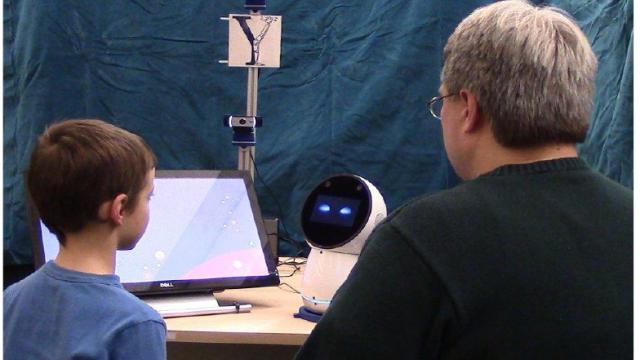As excited or terrified as we might be by the latest advances in robot technology, they’re still far from being the ubiquitous helpers portrayed in science fiction. But a new study published this week in Science Robotics does seem to offer a glimpse of their potential in assisting children who have communication differences due to autism spectrum disorder (ASD).
Its findings suggest that a month of robot-aided lessons might just help these children learn to communicate more effectively.
Autism is a complicated neurological disorder, brought on by environmental and genetic risk factors (though not vaccines) that work together in ways we don’t completely understand. Manifestations of ASD can vary from person to person, but they often include trouble interacting and communicating with others, such as by being unable to maintain eye contact.
So-called social robots have shown promise as a way to teach young children with communication differences to better handle social situations.
“Robots are the perfect combination. They’re social enough to get people to respond to them, but they’re not too social that they provoke any anxiety,” lead author Brian Scassellati, a roboticist at Yale University and head of the university’s Social Robotics Lab, said in a video released by Yale.
But according to Scassellati and his team, much of this research has only studied short bursts of interaction between children and robots, usually in a controlled lab setting. So the team decided to take things one step further.
For the experiment, they recruited 12 families of children who have communication difficulties due to ASD. The children, who were between the ages of six to 12, and their families were given a special computer setup to use at home, one that included an early prototype of Jibo, a 30cm robot developed at MIT that is marketed as the first commercial social robot.
Jibo, which carries more than a passing resemblance to the WALL-E robot character Eve, responds to voice commands, can rotate its body and head 360 degrees, and features a black screen “face” with a pair of eyes that blink and indicate emotions such as happiness and sadness.
The children, along with their caretaker, interacted with Jibo every day for 30 minutes. As part of the session, they would play several games on the nearby computer touchscreen. These games reinforced aspects of communication, such as reading others’ emotions or understanding their perspective. One game, for example, asked children to figure out what a character was feeling at a certain point in a story.
Jibo, which was programmed with a variety of premade scripts, would encourage the children as they played and adjusted the difficulty of the games depending on how well they had already done. Jibo also “modelled positive social skills,” according to the study, such as making eye contact with the children and looking at the screen at the same time as they did.
All of these sessions were recorded through cameras and microphones, and the caretakers documented the children’s overall level of social interaction with others.
As expected, the children got better at the games as time went on, with most being able to complete the highest levels of each one by the end of the month-long study. But outside of their robot sessions, the children also showed improvement in their ability to pay attention to the same thing as the adult they were with, a skill known as joint attention.
The caretakers also reported that their children became more socially adept, willing to make more eye contact and to communicate more with others.
“It really just showed me just how bright he is, and how quick he is. This really brought out good qualities in him,” said the mother of a child involved in the experiment, also featured in the Yale video.
The study, the authors note, is only meant to be a proof of concept. There’s still a lot of ground to be covered and questions to be answered regarding the use of robots in autism treatment. It would take a robot much more sophisticated than the already outdated Jibo to work effectively with children with ASD for longer time periods, the authors point out. Such a robot would need to adapt to people on the fly and provide more complex lessons.
And the beneficial effects of these sessions aren’t guaranteed to last once they end. In the current study, children’s improvement in their joint attention skills started waning 30 days after the experiment had ended. The study sample itself — 12 relatively healthy children who had previously worked with the researchers — also might not be representative of how other children living with ASD would respond to robots in their home.
Still, it’s worth studying just how useful robots can someday be. “Future work with larger and longer trials will clarify this promising, yet preliminary, result,” the authors wrote.
